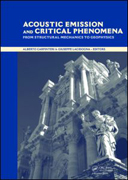
Acoustic emission and critical phenomena: from structural mechanics to geophysics
Carpinteri, Alberto
Lacidogna, Giuseppe
The Acoustic Emission (AE) technique uses ad hoc transducers to detect AE events caused by crack growth in structures under external loading. This technique is similar to the one employed in earthquake control, where seismic waves reach the monitoring stations placed on the surface of the Earth. And although they take place on different scales, these two phenomena – damage in structuralmaterials and earthquakes in geophysics – are very similar. In both cases a release of elastic energy from sources located inside a medium occurs.Both earthquakes and AE signals can be seen as critical phenomena and follow the Guttenberg-Richter frequency-magnitude relationship under a wide variety of conditions. The number of earthquakes and AE signals scale as a power-law ofthe area of the rupture zone, where fractal scaling is proposed for the spatial and temporal distributions of earthquakes and AEs. In addition, earthquakescan be taken as an example of the notion of self-organized criticality, sincethis idea describes the spontaneous organization of the dynamics of a system towards a very particular state, analogous to the critical point found in equilibrium phase transitions. It is also pointed out that brittle failure phenomena, as identified through AE monitoring in concrete, masonry and rocks, can beconsidered as critical phenomena.
- ISBN: 978-0-415-45082-9
- Editorial: Taylor & Francis
- Encuadernacion: Cartoné
- Páginas: 270
- Fecha Publicación: 01/03/2009
- Nº Volúmenes: 1
- Idioma: Inglés
